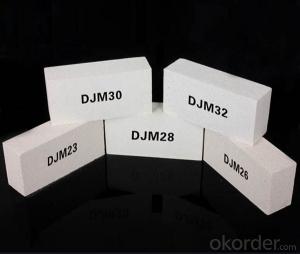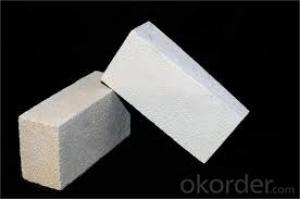65% Al2O3 Min High Alumina Insulating Fire Brick
- Loading Port:
- China main port
- Payment Terms:
- TT or LC
- Min Order Qty:
- 100 pc
- Supply Capability:
- 2000000 pc/month
OKorder Service Pledge
OKorder Financial Service
You Might Also Like
65% Al2O3 Min High Alumina Insulating Fire Brick
High alumina insulating fire brick is a kind of insulation material adopting organic matter as ignition loss substance in order to increase the porosity of refractory, which has such advantages as high porosity, small volume density, good insulation effect, high mechanical intensity, small thermal conductivity and long service life. For various industrial kilns & furnaces, it is a kind of essential refractory for energy saving and temperature preservation.
This series of High Alumina Insulating Fire Brick are made of selected high alumina bauxite, kaolin caly, hollow microsphere as the mian material.By shaping at high pressure and sintering at high temperature.
Product Applications:
High alumina insulating fire brick are ideal for use in the below applications
Building materials for blast furnace
Building materials for hot-blast stove
Building materials for coke oven
Building materials for steel making furnace
For construction material in steel industry
For ladle
Product Advantages:
CNBM has success in its High alumina insulating fire brick due to their cost-effectiveness and excellent insulating properties. The refractoriness of magnesia chrome bricks are more than 2000°C, and the refractory under load is a above 1550°C.Good steady volume in high temperature, the performance of meeting sudden cold and sudden hot is better than magnesia bricks.
Main Product Features:
Excellent thermal stability
High refractoriness under load
Chemical stability and anti-corrision
Small high temperature creep rate
Excellent thermal shock resistance
Product Specifications:
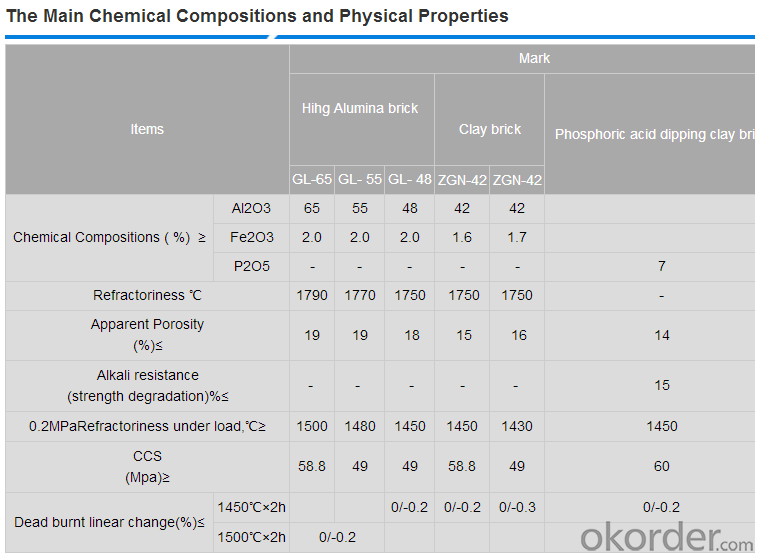
FAQ:
Q1: Are you a manufacture or trader?
A1: Factory+trade (mainly for manufacturing, also do some business of related products).
Q2: What's the MOQ of trial order?
A2: No limit,We can offer the best suggestions and solutions according to your requirements.
Q3: After an order is confirmed,when to deliver?
A3: According to your order quantity, normally, 15-25 days after deposit received.
Q4: Is your company accept customization?
A4: We have our own factories and excellent technical team, and we accept OEM service.
Product Picture
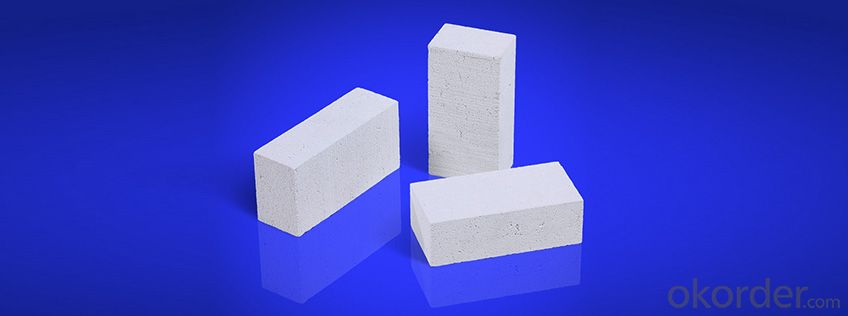
Produce Processing
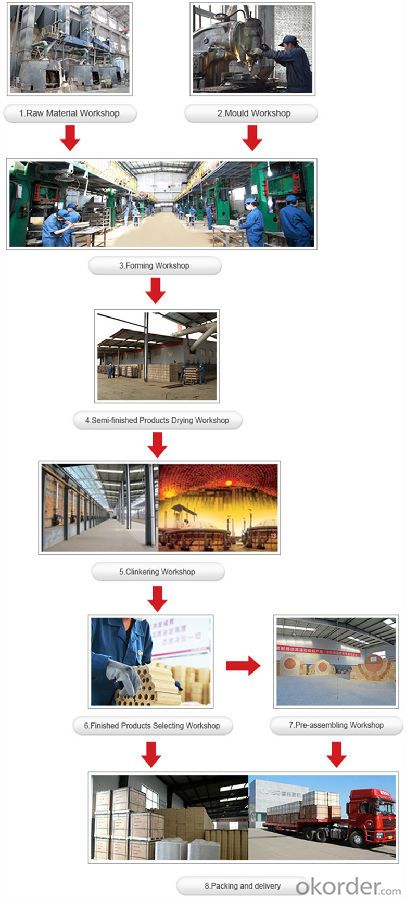
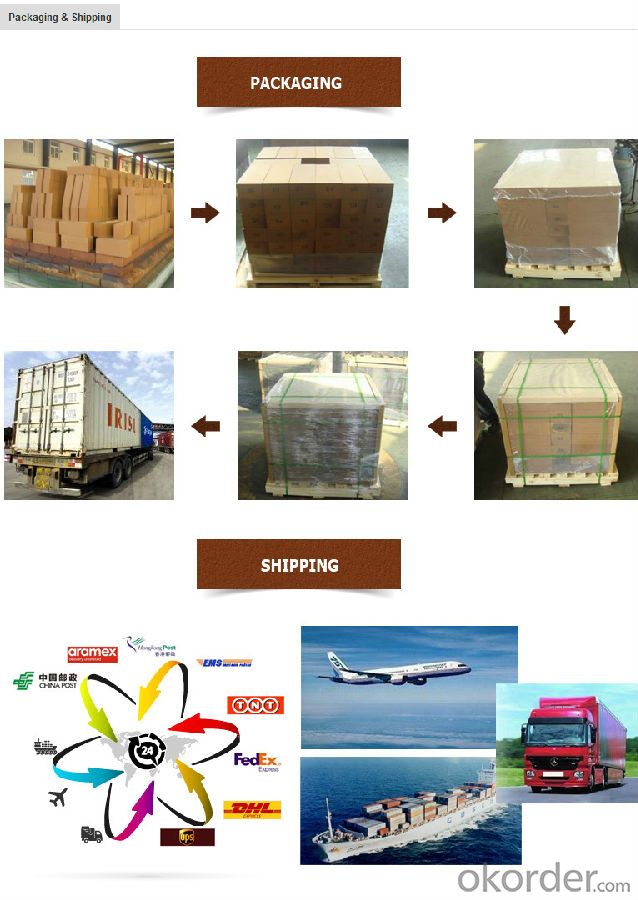
- Q:Are insulating fire bricks resistant to slag attack?
- Yes, insulating fire bricks are generally resistant to slag attack. Insulating fire bricks are made from lightweight and porous materials, such as alumina, silica, and other refractory materials. These bricks are designed to provide excellent insulation and high-temperature resistance in various industrial applications, including furnaces, kilns, and incinerators. Slag attack refers to the corrosion or erosion caused by molten slag, which is a byproduct of certain industrial processes like metal smelting or coal combustion. Slag can be highly corrosive and can cause damage to refractory materials, including fire bricks. However, insulating fire bricks are specifically formulated to have a high resistance to slag attack. Their composition and structure allow them to withstand the corrosive nature of molten slag, preventing erosion and maintaining their insulating properties over time. Moreover, insulating fire bricks can also have different levels of slag resistance, depending on their specific composition and manufacturing process. Some fire bricks may have additional additives or coatings to enhance their resistance to slag attack. It is important to note that while insulating fire bricks offer good resistance to slag attack, the severity and duration of exposure to slag can also impact their performance. In highly corrosive environments or prolonged exposure to molten slag, even the most resistant fire bricks may eventually experience some level of degradation. Overall, insulating fire bricks are a reliable choice for applications where resistance to slag attack is required. However, it is always recommended to consult with a refractory engineer or supplier to ensure the appropriate selection of fire bricks based on the specific conditions and requirements of the industrial process.
- Q:Are insulating fire bricks suitable for use in lime kilns?
- Yes, insulating fire bricks are suitable for use in lime kilns. They have high insulating properties that help to maintain high temperatures inside the kiln while minimizing heat loss. This is important for efficient lime production. Additionally, insulating fire bricks are resistant to the corrosive nature of lime, making them a durable and reliable choice for lime kilns.
- Q:The insulation layer destroyed after use of cement paste and tiling
- Attach tiles directly to the insulating layer. But one requirement is to check the insulation process in the balcony of your house. Usually wall - insulation layer - galvanized wire mesh - cement mortar, scraping - paint. If the lack of process fill such as galvanized mesh, remove paint, and tiling. You can use high mark cement or direct adhesive.
- Q:Can insulating fire bricks be used in the construction of steel production furnaces?
- Yes, insulating fire bricks can be used in the construction of steel production furnaces. Insulating fire bricks are specifically designed to withstand high temperatures and provide excellent thermal insulation, making them suitable for use in various industrial applications, including steel production. These bricks are made from lightweight materials that have low thermal conductivity, allowing them to effectively reduce heat loss and improve energy efficiency in furnaces. Additionally, insulating fire bricks have good resistance to thermal shock, which is important in steel production processes that involve rapid heating and cooling. Overall, the use of insulating fire bricks in the construction of steel production furnaces can help optimize performance, reduce energy consumption, and enhance the overall efficiency of the steelmaking process.
- Q:Are insulating fire bricks suitable for use in kilns and furnaces?
- Yes, insulating fire bricks are suitable for use in kilns and furnaces. They are designed to have excellent insulation properties, which helps to reduce heat loss and improve energy efficiency in these high-temperature environments. Additionally, insulating fire bricks can withstand the extreme temperatures found in kilns and furnaces without cracking or breaking, making them a reliable and durable choice.
- Q:Do insulating fire bricks require a refractory mortar for installation?
- For proper installation, insulating fire bricks typically require the use of refractory mortar. These bricks are lightweight and have excellent insulating properties, making them well-suited for applications that prioritize thermal efficiency. However, their lightweight nature also means they are more fragile and susceptible to cracking or breaking when subjected to stress. To establish a robust and durable bond between the bricks, it is essential to use a refractory mortar specifically designed for high-temperature applications. These mortars are formulated to withstand high temperatures and possess superior adhesion and thermal expansion properties. By filling in the gaps between the bricks and providing additional support, this mortar helps create a solid and secure structure. Failure to use refractory mortar can lead to inadequate securing of the insulating fire bricks, potentially causing them to shift or separate over time and compromising the integrity of the installation. Additionally, the absence of refractory mortar may result in reduced thermal efficiency due to increased heat loss through gaps and spaces between the bricks. Therefore, it is highly advisable to employ refractory mortar when installing insulating fire bricks to ensure the construction remains strong and long-lasting.
- Q:Can insulating fire bricks be used in the construction of heat exchangers?
- Insulating fire bricks have the capability to be utilized in the construction of heat exchangers. These bricks are specifically designed to possess exceptional thermal insulation properties, thereby rendering them ideal for situations where the maintenance or control of high temperatures is necessary. Heat exchangers, which are devices responsible for the transfer of heat between two or more fluids, require insulation in order to prevent any loss or gain of heat during the process. The incorporation of insulating fire bricks in the construction of heat exchangers aids in the reduction of heat transfer to the surrounding environment, ultimately resulting in enhanced energy efficiency and decreased operational expenses. These bricks are capable of withstanding high temperatures, typically reaching up to 3000°F (1650°C), thus making them suitable for various heat exchanger applications, such as furnaces, boilers, and industrial processes. Moreover, insulating fire bricks possess the additional benefits of being lightweight and having low thermal conductivity. This means that they provide effective insulation while also being less bulky and more cost-effective compared to traditional refractory bricks. Consequently, they are easier to handle and install within heat exchanger systems. In conclusion, the utilization of insulating fire bricks in the construction of heat exchangers offers numerous advantages, including improved thermal insulation, enhanced energy efficiency, and reduced expenses.
- Q:Can insulating fire bricks be used in hydrogen furnaces?
- Insulating fire bricks possess the capability to be utilized in hydrogen furnaces, although it is imperative to acknowledge that not all variants of insulating fire bricks are suitable for this particular purpose. Due to the highly reactive nature of hydrogen gas, certain materials can deteriorate or react, thereby giving rise to concerns regarding safety and potential harm to the furnace. When making a selection of insulating fire bricks for employment in hydrogen furnaces, it becomes crucial to opt for bricks that are explicitly designed for environments characterized by high temperatures and corrosive conditions. These bricks ought to be constructed from materials that exhibit resistance against hydrogen embrittlement and possess a low reactivity with hydrogen. Silicon carbide (SiC) and alumina-silica (Al2O3-SiO2) are frequently utilized materials for insulating fire bricks within hydrogen furnaces. These materials boast remarkable resistance to elevated temperatures and remain chemically stable when exposed to hydrogen. Moreover, it is of utmost importance to take into account the density and porosity of the insulating fire bricks. For hydrogen furnaces, it is preferable to employ bricks with low density and high porosity, as they offer enhanced thermal insulation and diminish the likelihood of hydrogen leakage. In conclusion, while insulating fire bricks can be employed in hydrogen furnaces, it is crucial to meticulously select the appropriate type of bricks that are specifically engineered for high-temperature and corrosive environments, and exhibit commendable resistance against hydrogen embrittlement and reactivity. Seeking consultation from specialists in the field and adhering to the guidelines provided by the manufacturer is highly recommended to ensure the safe and efficient operation of the hydrogen furnace.
- Q:Are insulating fire bricks resistant to alkali-silica reaction?
- Insulating fire bricks (IFBs) are not inherently resistant to alkali-silica reaction (ASR). ASR is a chemical reaction that occurs between the alkalis from cement and reactive forms of silica present in aggregates, which can lead to the formation of a gel that expands and causes cracking in concrete structures. While IFBs are generally made from refractory materials that are designed to withstand high temperatures and thermal shock, they do not have specific properties to resist ASR. The resistance to ASR depends on the composition and characteristics of the specific refractory material used in the IFB. If the refractory material used in the IFB contains reactive forms of silica, such as quartz or cristobalite, and there is exposure to alkalis, there is a possibility of ASR occurring. However, if the refractory material is low in reactive silica content or contains additives that can mitigate ASR, the risk of ASR may be minimized. It is important to note that the primary purpose of IFBs is to provide insulation in high-temperature applications, such as kilns, furnaces, and fireplaces. If ASR resistance is a critical requirement for a specific application, it is recommended to consult with the manufacturer or a materials engineer to determine the suitability of the IFB for that particular scenario.
- Q:Are insulating fire bricks resistant to chemical attack?
- Insulating fire bricks are generally known for their resistance to chemical attack. These bricks consist of high-purity refractory materials, such as alumina or silica, which possess excellent chemical stability. Their design allows them to endure high temperatures, making them highly resistant to the corrosive effects of chemicals. However, it's worth noting that the extent of chemical resistance can vary depending on the specific composition of the insulating fire brick and the type of chemical used. In some instances, certain aggressive chemicals may still cause gradual degradation or erosion. Hence, it is always advisable to consult the manufacturer or supplier for precise information regarding the chemical resistance of insulating fire bricks, considering their intended application.
1. Manufacturer Overview |
|
|---|---|
| Location | |
| Year Established | |
| Annual Output Value | |
| Main Markets | |
| Company Certifications | |
2. Manufacturer Certificates |
|
|---|---|
| a) Certification Name | |
| Range | |
| Reference | |
| Validity Period | |
3. Manufacturer Capability |
|
|---|---|
| a)Trade Capacity | |
| Nearest Port | |
| Export Percentage | |
| No.of Employees in Trade Department | |
| Language Spoken: | |
| b)Factory Information | |
| Factory Size: | |
| No. of Production Lines | |
| Contract Manufacturing | |
| Product Price Range | |
Send your message to us
65% Al2O3 Min High Alumina Insulating Fire Brick
- Loading Port:
- China main port
- Payment Terms:
- TT or LC
- Min Order Qty:
- 100 pc
- Supply Capability:
- 2000000 pc/month
OKorder Service Pledge
OKorder Financial Service
Similar products
New products
Hot products
Related keywords
